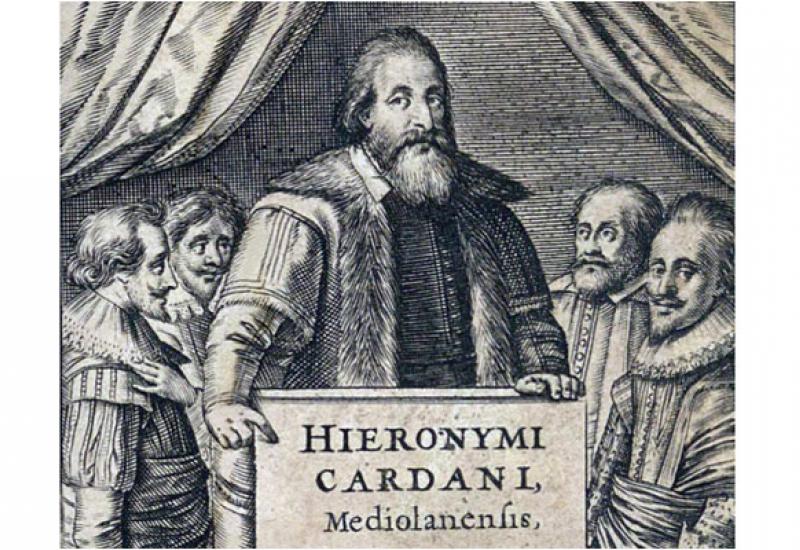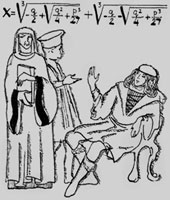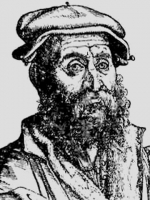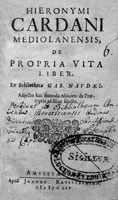Propeller shaft, drive coupling, gimbals - these things are now well known, especially to auto mechanics and inertial navigation specialists. Mathematics know the formula Cardano, specialists in encryption affairs - "lattice Cardano." All this is the work of the great mathematician, engineer, geologist, astronomer - in a word, encyclopedic of Renaissance Gerolamo Cardano. However, he considered himself first and foremost an outstanding physician - in his autobiography "On my life," even compared himself to Hippocrates, Galen and Avicenna!
Origin
He was born September 24, 1501 - exactly 510 years ago - in the ancient city of Pavia, northern Italy. 510 years - the date, of course, not "round", but 10 years ago about 500th anniversary of one of prominent representatives of the Renaissance, it seems almost no one remembered. Probably the temporal distance is the cause: we will gladly celebrate centenary, even two hundred years, but further back in history almost never look. Perhaps because the people who lived so long ago, are seemed to us semi-mythical creatures, despite their accomplishments and achievements. However, they lived, and about the lives of some of them, such as Cardano, we know quite a lot.
Gerolamo Cardano's father was a prominent lawyer, whose name is found even in the notes of Leonardo da Vinci, but the boy was born out of wedlock. This fact hampered him in the future, because when graduating the University of Padua in 1526, he tried to get medical practice in Milan, he was not accepted in the city College of Physicians. However, he began to treat, but in a provincial town Gallart. At the same time he selflessly continued to explore the mysteries of medicine, and even began to write treatises on medicine. He was also interested in philosophy, astrology, and much more. Around the same time, he began a career and a lecturer in mathematics: the science attracted him since childhood, and in his youth he has achieved success in it no less, and perhaps more than in medicine. And he was constantly perfecting skills in gambling, which took part in his young age. And not only played, but also trying to find certain patterns in the game, which eventually resulted in one of his well-scientific works - "The Book of the dice," which contained the beginning of probability theory, combinatorics, even psychology (of course, games and players). Note that this book was written when he was still a very young man - in 1526, but he printed it only in 1563.
Erudite of Renaissance
In general, he wrote a lot of books during his life. After all, he was not only engaged in medicine and mathematics, but also in philosophy, chemistry, geology, mineralogy, calendaring, astronomy and astrology, and of course, he was inventing and constructing various technical devices. It is known 138 of his published works, totaling about 7,000 pages of large format - in folio. There was even a kind of encyclopedia of the author - the book "On the delicate matter" and "About a variety of things." In addition, about 100 (!) books he destroyed himself in anticipation of arrest for a few years before his death.
In all sectors, which Gerolamo Cardano was engaged, he achieved considerable success. It is known, for example, that his services as an astrologer were required even by the Pope (in those years horoscopes considered quite pleasing to God). There is even a version that his death was not accidental: that he committed suicide, to confirm his own compiled horoscope. Information about the features of his character, which have reached our time, if not forces to believe in this dark legend, then at least explains much of his life.
Reckless, vindictive, desperate, sharp-tongued, for the sake of achieving ready for any actions simultaneously noble and faithful in friendship, Cardano, of course, was an extraordinary person. No wonder the great German mathematician and philosopher Gottfried Wilhelm Leibniz said about him: "Cardano was a great man with all his faults, and without them he would be perfect." It should be noted that these deficiencies were the result of severe childhood. His mother thought he was a burden of shame as shy and often vented their anger on him by beating. The father lived separately and at meetings limited his educational impact with spanking. At the same time Cardano could not boast a good health being a child or an adult. Therefore, what others received without any effort, he had to pull out of life. It is obvious that in many respects the early experience of survival formed both positive and negative aspects of his character and the desire for recognition.
The latter was in its life is extremely important. It is known, for example, that even well-known device that was named after him and is now known as the propeller shaft or gimbal, was appeared in 1541 as a result of the fact that Cardano (the rector of the City College of Physicians ) was among the most respected citizens of Milan was honored to participate in the meeting of the Spanish king Charles V. He even walked near the royal canopy. Touched by this display of respect, he suggested to equip the monarch’s carriage with the suspension of two shafts which relative rotation will keep it in a horizontal position. The idea of such suspension has been known for a long time, and even founded a place in the "Codex Atlanticus" Leonardo da Vinci.However, with this information the educated people were able to meet only after two centuries. After the publication of Cardano this design started to be used in various embodiments.
Mystery of cubic equations
Around the same years, Cardano was actively engaged in mathematics. Back in the thirties, he started to work on a large treatise on arithmetic, the first edition of which was published 1539. "The practice of general arithmetic" earned him recognition among experts in mathematics, but the author himself was not too pleased. The reason was that it did not reflect a clue what was then the mathematical secrets that although he owned, but could not be made public circumstance connected with the author of this discovery.
We are talking about how to solve cubic equations. Or, rather, about the recipes of their decisions, because for the introduction of algebraic symbolism was still more than a hundred years, and how to find the roots of equations, mathematics explained with descriptions of the necessary actions, often - Latin verse.
To solve this problem, European and Arab mathematicians were approached for several centuries. In 1494, the famous Italian scientist Luca Pacioli in his book "The amount of arithmetic" even authoritatively stated that the solution of cubic equations "art of algebra yet not given way, as not given way to square the circle, "and therefore must be regarded as" impossible. "This statement has distracted many mathematicians from further attempts to solve the problem.
Many, but not all.
Around 1515, Professor University of Bologna Scipio del Ferro (1456-1526) has invented a way of solving cubic equations of the form x3 + ax = b. Before his death, his secret Ferro opened only son-Annibale della Nave and his pupil Antonio Maria Fiore. The latter decided to use the knowledge to gain in tournaments in solving various mathematical problems, which were then widespread in Europe. Victory in such tournaments brought respect, cash awards and the opportunity to get a decent position in some of the universities..
Tartaglia and his victory
In those times, a young mathematician from Verona Niccolo Fontana, known in the history of science by the nickname Tartaglia, which translated from Italian meant "stutterer" joined the problem of solving cubic equations. His surname he was obliged to injury from saber wounds of the face and palate received as a child from a French soldier - one of the conquerors of his home town of Brescia during the war with the Venetians. After that he could not talk freely. But the injury did not prevent him to learn and study science. It was quite a feat, because his family was very poor. The father, who worked as a postman, died when he was only six years old. His mother had two more children except him. Even the school he attended for only 15 days, and then had to work and learn in those days, when other children were playing in the street. Yet, his success in mathematics was so great that he soon began to earn a living by lessons and consulting engineers, gunners, merchants, architects and builders. Moreover, he translated the works Archimedes and Euclid in living Italian and also wrote his own books on the practical application of mathematics and mechanics.
Once, to help in solving problems of cubic equations, he was approached by a teacher Brescia de Koi. Tartaglia indignantly refused – saying that he does not even want to take up the notoriously intractable problem. However, he became interested in the problem, and after a while Tartaglia was able to find a way to construct the graph of a cubic equation of the form x3 + ax = b and began to declare that captured large algebraic secret. Rumors about it have reached Antonio Fiore, who did not believe them. The same, incidentally, was thinking about Fiore and Tartaglia, who learned about the will del Ferro.
However, confident in his "secret weapon", del Ferro called Tartaglia in 1535 to compete in terms of which rivals exchanged through a notary thirty problems. To solve them it were given fifty days. The winner is the one who will solve more problems. Of course, all 30 tasks, suggested by Fiore were the cubic equations with different coefficients. To find the key to solving them, Tartaglia had to exert maximum efforts. In the end, eight days before the date when the decision had to be given to the notary, he found a way to succeed. Therefore, the proposed problems, he solved within two hours. The next day, he found a way to solve cubic equations of the form x3 = ax + b, which are due to the fact that the negative numbers in those days had not yet used, were considered different from the above. As for Fiore, he could not solve the problems selected by Tartaglia on various sections of algebra and geometry,.
The news about the brilliant victory Tartaglia not only over Fiore, but on a mathematical puzzle of centuries, spread rapidly throughout Italy. Cardano, who cherished the ambitious dreams that mathematical treatise, which he had just written, will replace the classic book of Luca Pacioli, lost his mind. He began literally to chase Tartaglia asking him to open his secrets. He steadfastly refused, even suspecting that Cardano was working for de Koi. However, oddly enough, after a while Cardano yet reached his goal! How he made Tartaglia - man, according to the memoirs of contemporaries far from angelic nature - to part with his secret, it is not clear. But the fact remains: Latin verses Tartaglia said Cardano about his recipe, though without specifying any hints on his obtaining. In exchange, Cardano was forced to swear that he will not open secret to anybody. Therefore, he had no right to print the solving in his book!
"Great art"
Several years Cardano spent scrutiny and justification derived rules. And no wonder: algebraic symbolism did not yet exist, and even the use of ready-made ways, not to mention their obtaining, was a very difficult matter. But Cardano did. In fact, he found a way to solve equations of the form x3 + b = ax, and then the full cubic equations. These equations were solved , using the necessary arguments, which played upon negative roots. He allowed their existence, although called "fictitious" or "less pure". Thus, it is the first among mathematicians Cardano began, albeit very cautiously handle negative numbers. Moreover, Cardano even allowed for the possibility to use in the calculation of complex numbers, so in the end you can get the real roots of equations.
In 1543 Cardano, along with his best student Luigi Ferraris visited in Bologna Professor Scipio del Ferro - Hannibal della Navi (as already mentioned, della Navi was one of two people whom was trusted with secret). Del Ferro without any objection allowed them to get acquainted with the test paper in which they have already found a familiar description of the method of solving cubic equations. Now it did not bind Cardano – there was another source from which it was possible to obtain a treasured formula. The way to its publication has been opened! Gerolamo Cardano has already started work on a systematic description of what was then known of algebra, so without further ado, he included in his book "Great art, or On the rules of algebra" (in the history of mathematics it often simply called "Great art ") section of the cubic equation with the preface to the history of the issue.
The book was published in 1545 and caused a frenzy of Tartaglia. He tried to take revenge, spreading insulting letters, in his book "Challenges and various inventions" (1546) accused Cardano. Instead Cardano, already mentioned his pupil Ferrari entered into debate. He was also an outstanding mathematician, studies which, with appropriate references to the author were also included in the "great art". Ferrari even called Tartaglia to a public debate, which he shamefully lost. But the formula for the solution of the cubic equation since it has been linked with the "great art" and eventually it got the name of "Cardano formula".
... The last years of his life were not easy for Cardano. One son poisoned his wife with jealousy and was executed. The second became a player and robbed his own father. In 1570 Cardano was prisoned - he was haunted by the Inquisition. Seven months later, he was released on bail without the right to publish his works and teach. He moved to Rome and deepened into medical practice. However, in 1575 again took up his pen - began writing the book "On my life." In it, he thought about his appointment, summarized the achievements and failures, recalled the unusual cases that happened to him. This book is a valuable source of information not only about his fate, but also about those times ...
- Gerolamo Cardano
- Title page autobiography Cardano D. "On my life"
- Tartaglia




